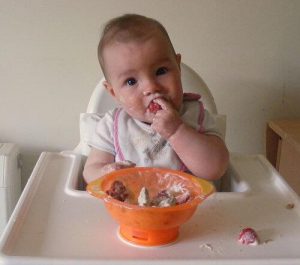Suggestions for Complementary Feeding

Complementary feeding is when you start incorporating new foods into your child’s diet – this can involve solid, liquid, and semisolid components — while you continue to breastfeed.
A complementary diet is recommended for babies age six months and older. It helps provide babies with more nutrients as they continue to grow.
Complimentary feeding means introducing a variety of foods to your baby’s diet, in addition to breast milk. But it’s important to note that the new foods don’t serve as a substitute for breast milk, which babies should consume for at least 24 months.
These complementary foods have specific characteristics; certain foods are not recommended for babies.

Characteristics of a complementary diet
The purpose of complementary feeding is to solve nutritional deficiencies that breast milk doesn’t cover. When your baby gets bigger, they have more nutritional needs. This also applies to formula fed babies.
As such, these foods should have the following characteristics:
- Nutrients that provide energy
- Easy to swallow and digest
- Simple and not harmful for infants
- Rich in iron, to offset the milk deficiency
- Easy for the child to feed themselves with
- Quantities based on their needs
- The temperature should be similar to their body temperature, around 100 degrees Fahrenheit. You can chill or heat the foods to get them to the appropriate temperature
The foods you incorporate into your baby’s diet when they’re six months old should also help them learn to eat and use utensils.
As such, we should let them eat on their own. We should allow them to pick up foods with their hands, recognize smells and textures, and bring the foods to their mouth.
Your child should also recognize their own plate, spoon, and cup, which should be small and the right size for them.
Liquids aren’t recommended to be introduced through a bottle because this encourages gastrointestinal issues and delays the transition between breastfeeding and complementary foods.

When should we offer complementary foods?
Specialists recommend starting at six months of age. However, there are other criteria to consider before beginning this stage.
For example, it is important that the person in charge of feeding the baby dedicates time to properly preparing the baby’s food. They should also be prepared to feed the child and watch them patiently.
Additionally, it is important that the baby has developed sufficiently in regards to motor skills, senses and mentally. We recommend observing your baby until they begin to show signs of independence in day-to-day life. Once they do, complementary feeding can begin.
Other criteria to consider include:
- The baby should be fed during a peaceful moment. We want it to be a pleasant activity, not a punishment. It’s a good idea to not have fed them milk recently. They shouldn’t be too hungry, sleepy or crying.
- When you begin with complementary feeding, it is most important that the baby can sit on their own, either with assistance from a high chair or from an adult.
- Encourage them during family meal time so they will want to imitate everyone else. Bring their high chair to where the rest of the family is eating. This will allow them to socialize and recognize that it is a common activity. You can fill their plate with what everyone else is eating.
- It is advised to place the food in front of them or to put it in their hand. This allows them to practice the ability to grab food with force.
- Don’t force them to eat. They may need more time to observe and recognize food. It is important to be very patient and watch them all the time.
- It is recommended to introduce foods one by one. Once they have gotten used to the first food, then they can try another. This way they learn to differentiate textures and flavors.
Complementary feeding is when you start incorporating new foods into your child’s diet – this can involve solid, liquid, and semisolid components — while you continue to breastfeed.
A complementary diet is recommended for babies age six months and older. It helps provide babies with more nutrients as they continue to grow.
Complimentary feeding means introducing a variety of foods to your baby’s diet, in addition to breast milk. But it’s important to note that the new foods don’t serve as a substitute for breast milk, which babies should consume for at least 24 months.
These complementary foods have specific characteristics; certain foods are not recommended for babies.

Characteristics of a complementary diet
The purpose of complementary feeding is to solve nutritional deficiencies that breast milk doesn’t cover. When your baby gets bigger, they have more nutritional needs. This also applies to formula fed babies.
As such, these foods should have the following characteristics:
- Nutrients that provide energy
- Easy to swallow and digest
- Simple and not harmful for infants
- Rich in iron, to offset the milk deficiency
- Easy for the child to feed themselves with
- Quantities based on their needs
- The temperature should be similar to their body temperature, around 100 degrees Fahrenheit. You can chill or heat the foods to get them to the appropriate temperature
The foods you incorporate into your baby’s diet when they’re six months old should also help them learn to eat and use utensils.
As such, we should let them eat on their own. We should allow them to pick up foods with their hands, recognize smells and textures, and bring the foods to their mouth.
Your child should also recognize their own plate, spoon, and cup, which should be small and the right size for them.
Liquids aren’t recommended to be introduced through a bottle because this encourages gastrointestinal issues and delays the transition between breastfeeding and complementary foods.

When should we offer complementary foods?
Specialists recommend starting at six months of age. However, there are other criteria to consider before beginning this stage.
For example, it is important that the person in charge of feeding the baby dedicates time to properly preparing the baby’s food. They should also be prepared to feed the child and watch them patiently.
Additionally, it is important that the baby has developed sufficiently in regards to motor skills, senses and mentally. We recommend observing your baby until they begin to show signs of independence in day-to-day life. Once they do, complementary feeding can begin.
Other criteria to consider include:
- The baby should be fed during a peaceful moment. We want it to be a pleasant activity, not a punishment. It’s a good idea to not have fed them milk recently. They shouldn’t be too hungry, sleepy or crying.
- When you begin with complementary feeding, it is most important that the baby can sit on their own, either with assistance from a high chair or from an adult.
- Encourage them during family meal time so they will want to imitate everyone else. Bring their high chair to where the rest of the family is eating. This will allow them to socialize and recognize that it is a common activity. You can fill their plate with what everyone else is eating.
- It is advised to place the food in front of them or to put it in their hand. This allows them to practice the ability to grab food with force.
- Don’t force them to eat. They may need more time to observe and recognize food. It is important to be very patient and watch them all the time.
- It is recommended to introduce foods one by one. Once they have gotten used to the first food, then they can try another. This way they learn to differentiate textures and flavors.
All cited sources were thoroughly reviewed by our team to ensure their quality, reliability, currency, and validity. The bibliography of this article was considered reliable and of academic or scientific accuracy.
- D’Auria E., Bergamini M., Staiano A., Banderali G., Pendezza E., et al., Baby led weaning: what a systematic review of the literature adds on. Ital J Pediratr, 2018. 44 (1): 49.
- Arantes ALAE., Neves FS., Campos AAL., Pereira Netto M., The baby led weaning method (BLW) in the context of complementary feeding: a review. Rev Paul Pediatr, 2018. 36 (3): 353-363.
This text is provided for informational purposes only and does not replace consultation with a professional. If in doubt, consult your specialist.








